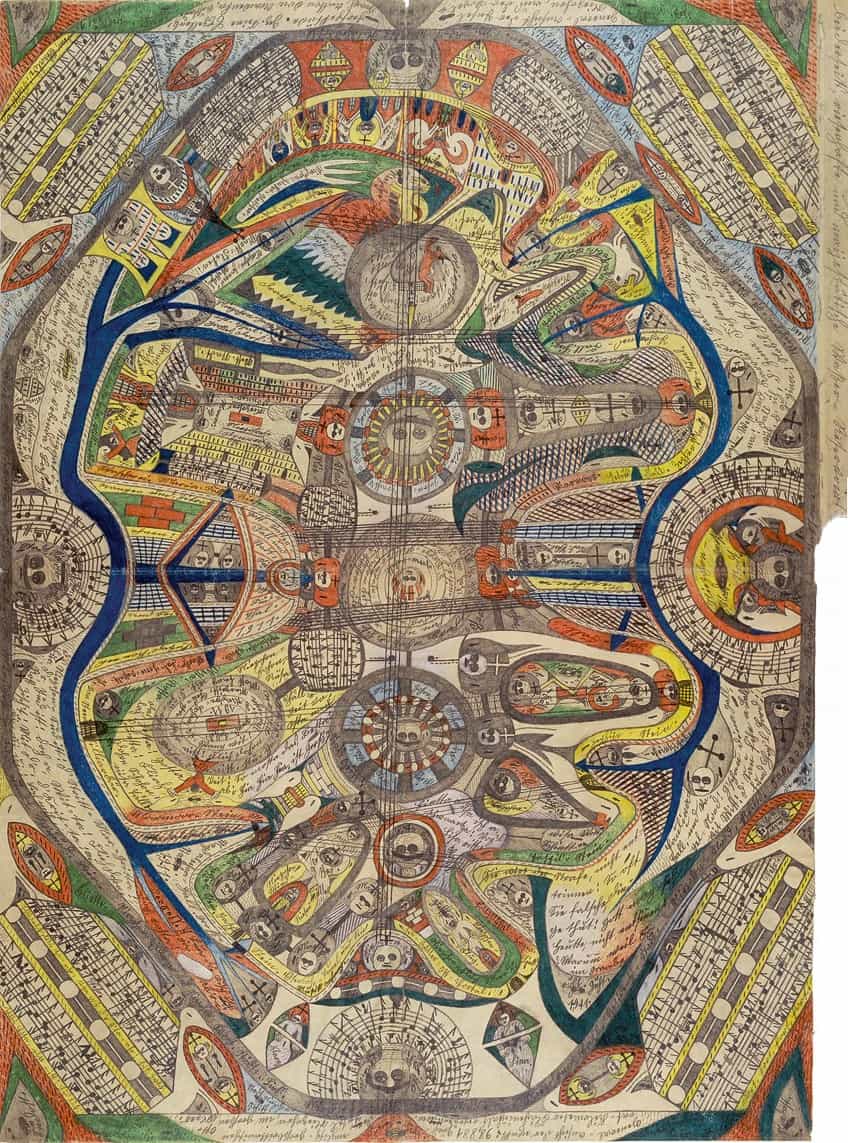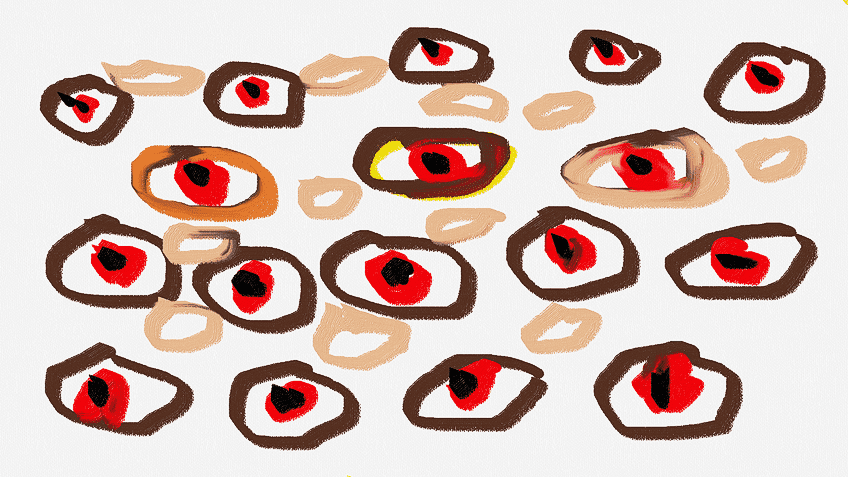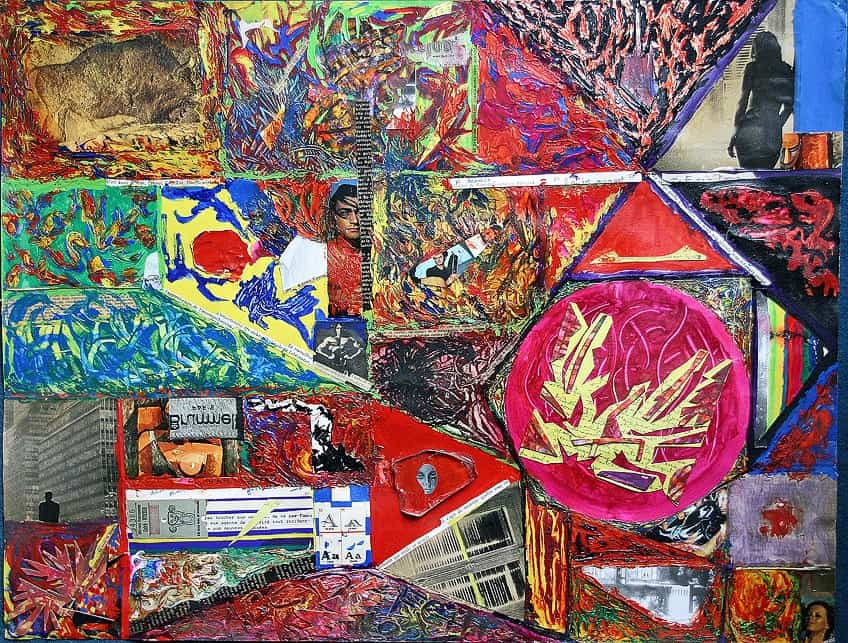What Is Art Brut? – A Look at Jean Dubuffet’s Art Brut
What is Art Brut or Outsider art? According to the Art Brut definition, Outsider artists offer a visionary interweaving of the fabric of existence, driven by unrelenting creative energy paired with a flair for awakening humanity’s innermost aspirations and anxieties. Jean Dubuffet, the French artist, created the term Art Brut to describe the artwork he admired created by introverted, secluded, and extraordinarily inventive individuals.
What Is Art Brut?
Although Jean Dubuffet’s art aimed to replicate independence from social limitations – both in theme and technique – in the same manner as the art he adored and collected did, his status and prestige inside the art world place him far from the category of an Outsider artist. In many respects, starting a movement in this circumstance is the polar opposite of the art contained inside it.
Nevertheless, the group he advocated for does serve to focus attention on a body of art created by people who are uninterested in self-promotion.
The History of Art Brut
The Der Blaue Reiter group is credited as being the first to show an interest in Outsider art, even studying the art of mentally ill people. They felt that spiritual qualities might be expressed via color and shape. These painters were drawn to the connections between music and art, in addition to the idea of synesthesia, which states that the stimulus of one sense can create an instinctive response in one or more other senses. Prinzhorn printed Bildnerei der Geisteskranken in 1922.
This book comprised rigorous assessments of hundreds of artworks created by mentally ill individuals at numerous European hospitals, which Prinzhorn had accumulated into a large collection.

Jean Dubuffet’s Influence on Art Brut and Outsider Art
Jean Dubuffet developed his collection of similar work after reading the book in 1923. Dubuffet, on the other hand, broadened the scope of his collections to incorporate artworks by other misfits and social outcasts creating art on the outskirts of society, not simply those with mental health challenges. He dubbed this style of art “Art Brut”. His Art Brut definition stated that “artworks done by individuals untainted by artistic cultural identity, artworks in which pastiche – in direct contrast to what occurs among academics – plays a minor or no part so that their creators generate it all from their assets instead of from the norms of traditional or trendy art”.
Jean Dubuffet, as well as other painters including André Breton, Jean Paulhan, Micheal Tapie, Charles Ratton, and Henri-Pierre Roche, founded the Compagnie de l’Art Brut in 1948, with artist Slavko Kopa serving as curator.
The group was meant to serve as a hub for additional research and curatorial efforts. The inaugural Art Brut show, held in 1949 at the Galerie René Drouin in Paris, had nearly 200 artworks on display. In 1951, right before the Compagnie’s breakup, due in part to a conflict in which Dubuffet blamed Breton for wanting to co-opt Art Brut into the vast global machinery of Surrealism, artist Alfonso Ossorio volunteered to host the artworks in his East Hampton home.

During this tour to the United States, Jean Dubuffet gave a lecture titled Anti-cultural Positions, in which he criticized Western society for repressing authentic creativity. The archive was kept in New York for 10 years before being returned to Paris, where Kopa functioned as archivist and curator once more.
Jean Dubuffet saw Art Brut as a source of motivation for his own work because he saw it as a more honest, real, and genuine expression of feeling, free of the absorbing effects of mainstream society.
He sought to replicate the youthful naiveté seen in Art Brut, but his expertise in paintings at an arts academy, in addition to his self-awareness as a painter and understanding of the conventional art world, implies that he ought not to be called an Outsider artist himself. His artwork is best classified as primitivism or faux-naive art.
Art Brut Goes Mainstream
Several elements led to the popularity of Art Brut in the first half of the 20th century. Many mainstream painters were drawn to Art Brut because it represented “Primitive” art from other countries. This might be attributed to rising unhappiness with the mainstream art scene, as well as a general skepticism of mainstream culture in the time after the two World Wars.
During this period, artists in the Western world experienced the tremendous devastation and turmoil caused by prevalent ideologies oriented on scientific, industrial, and rational paths of “development”.
During this time, people witnessed the sad and terrible execution of social theories such as Eugenics, which promised to enhance the general public’s standard of living by removing undesirable qualities such as mental disorders, incapacity, and criminal tendencies. The numerous atrocities committed during World War II drove many individuals, including artists, to become critical and distrustful of great ideas and ideologies, both outside and within the art world.

Many artists anticipated that celebrating the irrational and reaching out to those on the fringes of society would provide fresh sources of motivation for new approaches to understanding, connecting to, and depicting other individuals and the environment around us. Outsider art celebrations were therefore an alternative avenue for artists to “battle” against political injustices. “Art Brut may be understood as the extension and deepening of a broad and typical element of Modernism: the search for fresh and distinctive forms of creation in regions considered resistant to mainstream culture”, says author and artist David Maclagan.
In addition, many people in the art world clung to the romantic image of the crazy genius. The brilliance-insanity theory, which holds that genius is closer to insanity than normal intelligence, may be dated all the way back to Aristotle.
The concept entered popular consciousness during the Renaissance, blossomed during the Romantic era, and has yet to be put to rest. As a part of the Romantic period’s obsession with the crazy genius, artists turned their attention to madhouses, paying regular trips and documenting their impressions of insane painters in action to reply to the question “may the lunatic give rise to art?”

Artists began to notice that under the influence of mental illness, people who had never shown any interest in art gained an unexplainable need to form images, to sketch. This image of genius’s lunacy persisted into and into the 20th century, adding to the widespread perception of the creative person as a social pariah. This may be a faulty line of inquiry because it is typically societal wrongs that result in mental disease.
The surge in popularity of Art Brut, especially among the “mentally unstable,” was encouraged by parallel advancements in the fields of psychiatry and, subsequently, art therapy.
Medical experts who interacted with mentally ill and intellectually handicapped patients started looking at their patients’ artwork for clues concerning the nature of their maladies and disorders, or, to a certain extent, ways in which these ailments might be separated and classed.

This prompted many physicians to start gathering and evaluating patients’ paintings instead of simply tossing them, and a lot of these creative pieces eventually made their way into the public domain and into the clutches of popular artists looking for inspiration. The physician’s function as a translator of this new form of image was quite significant, depicting to a certain degree how it was perceived by the general public at first.
Nonetheless, like with Primitive Art, the creative artist perceived these motifs in his own distinct way.
The Concept of Outsider Art
In 1972, Outsider Art was coined as a term by Roger Cardinal, who was looking for an English counterpart to the French phrase Art Brut. Outsider Art is creative work created by self-taught artists that do not adhere to conventional or academic artistic standards and convey a strong feeling of individualism. These art forms, according to both Cardinal and Jean Dubuffet, are connected with creatives who are psychologically ill, but it also involves paintings by people who are perfectly capable of managing their personal interactions but who flinch, knowingly or unconsciously, from the concept of art being an overtly characterized exercise with collectively established criteria.
Outsider art or Art Brut, according to Cardinal, is based on the idea that producing art is a broad human activity that extends well beyond the realms of official galleries, educational institutions, and culturally designated art creation.

He continues to insist that a creator’s artwork’s designation as “Outsider” must be based on the anti-conventional essence of the craft making itself, its eccentricity, its often-otherworldly distance from artistic standards as well as widely accepted experience, as well as being regarded as an exhilarating visual experience it provides to its audience.
Art Brut Concepts and Accomplishments
Art Brut is a designation bestowed, sometimes retrospectively, by critics, historians, and collectors to self-taught individuals with little or no interaction with the traditional art world and its structures, rather than a trend with which creators self-identify. It is a completely random collection of artworks and painters with no underlying coherence or purpose. Similarly, the range of Outsider Art is now so vast that it is difficult to discover any evident unifying element, except that it impresses us as remarkable, both in terms of materials and subject, and that it appears to have been made out of nowhere.
Concepts
Indeed, this work is seen to be a manifestation of an individual mind, with a certain natural authenticity or purity. Outsider Art may be classified according to the medium used. However, there are additional labels associated with Art Brut that distinguish between distinct sorts of creators.
These concepts frequently overlap and are sometimes used improperly as synonyms.

Outsider Artists do have a predisposition to certain themes and motifs; thus, it is acceptable to argue that their art is divergent and unifiable. Portraits, birds, and fish, for example, are popular, as are binding, repetition, connecting, and completely occupying a particular area.
Achievements
When Outsider Artists turn into actual “artists,” they frequently have a breakthrough moment, similar to a religious calling. They often lack formal education in an art establishment and demonstrate a feeling of heightened connectedness within the complicated framework of universal balance in their works. Without having experienced sorrow, these artists are acutely aware of the dark forces as well as that of light. The Outsider artist is always engaged in battle in his or her head, navigating emotional turmoil to construct outer avenues to inner calm.
Surrealism is the closest more traditional movement similar, as its concept is also founded on the power of the human psyche.

Within Art Brut, we find a remarkable awareness of the central contradiction of being human: that as individuals, we are both everything and nothing. Outsider artists impart an effortless intimate understanding of philosophical connectedness through the continued usage of portraiture within this movement, which most individuals must research at length and sometimes even then do not fully get. Outsider artists often use patterning methods and compulsively repeated design elements. When they are generally affected by an awareness of the disorder, they seek to create basic and gratifying order.
Frequently Asked Questions
What Is Art Brut?
Fine art, according to Jean Dubuffet, was controlled by academic instruction, which he alluded to as cultural art. For Jean Dubuffet, art brut, which comprised graffiti and the artwork of the psychologically ill, inmates, adolescents, and primitive painters, was the unfiltered manifestation of a vision or feelings. He sought to merge these traits into his own art, which is frequently referred to as art brut.
What Materials Were Used in Art Brut?
Outsider Artists’ materials are not always the traditionally used art materials, which is part of the appeal and aesthetic for others. It is unusual for artists in this category to create simple sculptures or oil paintings. Typically, so-called outsiders utilize anything they can get their fingers on, whether it’s dirt, crayons, blood, or a basic ink pen, demonstrating a rare and remarkable ingenuity. This urgency of material reveals the tremendous drive to create, as well as the fact that the works created, are more like extensions of continuing reflecting selfhood than independent art pieces.
Jordan Anthony is a Cape Town-based film photographer, curator, and arts writer. She holds a Bachelor of Art in Fine Arts from the University of the Witwatersrand, Johannesburg, where she explored themes like healing, identity, dreams, and intuitive creation in her Contemporary art practice. Jordan has collaborated with various local art institutions, including the KZNSA Gallery in Durban, the Turbine Art Fair, and the Wits Art Museum. Her photography focuses on abstract color manipulations, portraiture, candid shots, and urban landscapes. She’s intrigued by philosophy, memory, and esotericism, drawing inspiration from Surrealism, Fluxus, and ancient civilizations, as well as childhood influences and found objects. Jordan is working for artfilemagazine since 2022 and writes blog posts about art history and photography.
Learn more about Jordan Anthony and about us.
Cite this Article
Jordan, Anthony, “What Is Art Brut? – A Look at Jean Dubuffet’s Art Brut.” artfilemagazine – Your Online Art Source. November 18, 2022. URL: https://artfilemagazine.com/what-is-art-brut/
Anthony, J. (2022, 18 November). What Is Art Brut? – A Look at Jean Dubuffet’s Art Brut. artfilemagazine – Your Online Art Source. https://artfilemagazine.com/what-is-art-brut/
Anthony, Jordan. “What Is Art Brut? – A Look at Jean Dubuffet’s Art Brut.” artfilemagazine – Your Online Art Source, November 18, 2022. https://artfilemagazine.com/what-is-art-brut/.



